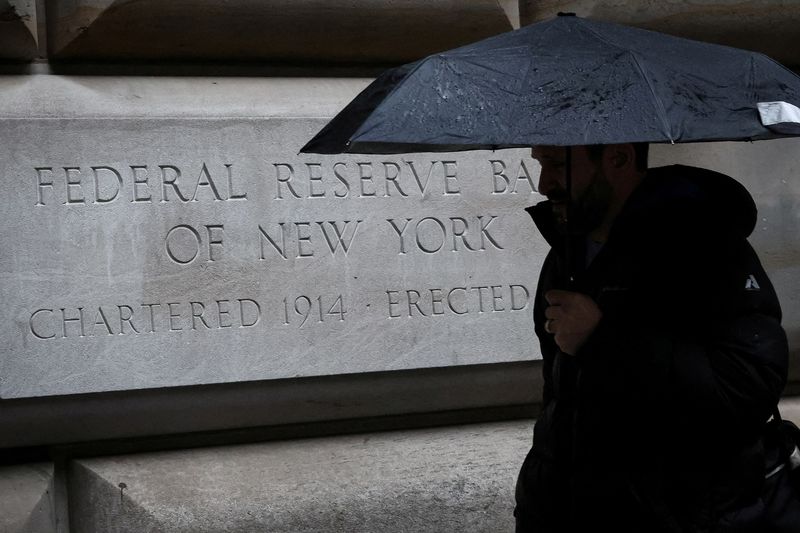By Mike Dolan
LONDON (Reuters) -Any real economy crunch from the U.S. Federal Reserve's balance sheet rundown may have been softened to date, but the air is rapidly escaping from one of its key cushions.
Whether last week's rhetorical shift by the Fed acknowledges this potential crunch is an open question, but credit and liquidity watchers are calling time on how long 2023's commercial bank reserves at the Fed can remain so stable.
Debate centers on the spaghetti of financial liquidity management related to the Fed's 'quantitative tightening', where it has been gradually offloading its still $7.8 trillion balance sheet hoard of bonds and bills over the past 18 months.
That stash, which more than doubled to a peak of almost $9 trillion last year after the pandemic shock, effectively bought bonds from banks and credited them with commercial bank reserves held at the Fed, against which those banks could then go on and lend on to business and households.
Since mid-2022, QT has been rolling these securities off the Fed's balance sheet at a pace of $95 billion a month.
But the Fed has also been soaking up what Atlanta Fed boss Raphael Bostic once described as "pure excess liquidity", via its daily reverse securities repurchase facility (RRP) - which at its peak in January hit £2.4 trillion.
Attractive as a parking lot for money market funds and banks as the Fed hiked the returns on these 'reverse repos' in line with its policy rates, the money tucked away there is now exiting at breakneck pace - scrambling to lock into a flood of new longer maturity bills and bonds before Fed rates fall.
Daily reverse repo totals have now dropped by about $1.6 trillion to just $768 billion last week.
And at the pace at which the RRP has deflated over the past three months alone, it will be gone by March - perhaps coincidentally the month in which Fed futures are now more than two-thirds priced for the central bank's first policy rate cut.
Maybe just the swings and roundabouts of the money market playground, but these moves may matter an awful lot: both to U.S. bank credit going into next year's economic slowdown as well as asset prices that many reckon feed directly off funding liquidity shifts in the system.
Societe Generale (OTC:SCGLY)'s Solomon Tadesse says the crux to how QT affects lending to the economy at large hinges on how it erodes bank reserves and this has been extremely muted so far due to all the excess cash piled into the reverse repo buffer zone.
Tadesse points out that during the only other prior example of Fed QT in action - 2017-2019 - bank reserves fell in lockstep with overall Fed balance sheet rundown.
But not this time.
BUMPY RIDE WITH NO CUSHION
"Bank reserves at the Fed, the main channel of QT's liquidity impact, remain unchanged despite asset shrinkage from QT as the financing of the growing government debt obligations were mostly absorbed by drawdowns in the Fed's reverse repo facility," Tadesse said.
In the less than two years of the previous QT campaign through 2019, the Fed's overall balance sheet was cut by more than $600 billion and bank reserves fell by over $800 billion.
Over the past 18 months, however, bank reserves are still where they were in the middle of 2022, even though some $1.1 trillion has been lopped off the Fed's balance sheet.
"In the 2017-19 QT, the Fed balance sheet asset sell-off came almost one-to-one from drawdowns in the Bank Reserves, thus draining liquidity from the system much faster...and leading to the liquidity squeeze of Sept 2019," Tadesse said.
"It is not currently like that as the RRP cushion is absorbing the expected liquidity drain from QT."
His key point is that as the RRP depletes further, QT will hit reserves and start to bite much more sharply into already deteriorating loan growth - which to date is largely down to falling demand for credit as borrowing costs rise and the investment horizon weakens from here.
And from there it will sap asset prices, he says, in a way liquidity analysts have puzzled all year that it hasn't done.
Presumably, the Fed can see this coming too.
But whether it's now changing policy tack to get across it is a moot point.
Last week, New York Fed chief John Williams claimed the depletion of the RRP was as designed, had some ways to go and reserve scarcity was some way off.
Earlier in November, the three newest Fed governors, including Vice Chair Philip Jefferson, told a U.S. senator it was unclear how much further the balance sheet wind-down will run but there was no fixed target and it faced no imminent end.
But left unchecked, the marriage of falling credit demand and supply could pack a greater punch to the U.S. economy next year than seen in the tightening process to date.
That may be just another version of the long and variable lags associated with the impact of monetary policy, but it may also underscore why the Fed is starting to prepare the way for a turn. The speed with it now shifts may dictate the fallout.
As to the impact on markets, other liquidity experts would insist that is more a function of global liquidity.
The latest weekly updates from CrossBorder Capital, chiming
with the U.S. bank reserves tune and ongoing credit easing in China, show nominal global liquidity levels actually picking up steam to just below the highest levels of the year. And that's before accounting for what now looks like an early pivot from the European Central Bank.

But for the U.S., next year may be a bumpier ride without a 'QT cushion'.
The opinions expressed here are those of the author, a columnist for Reuters.